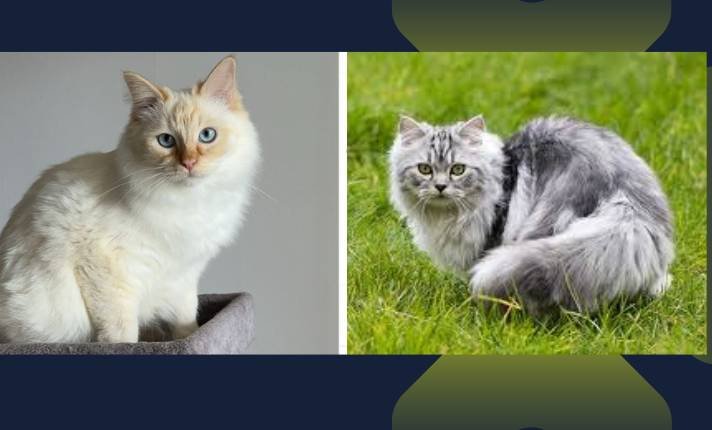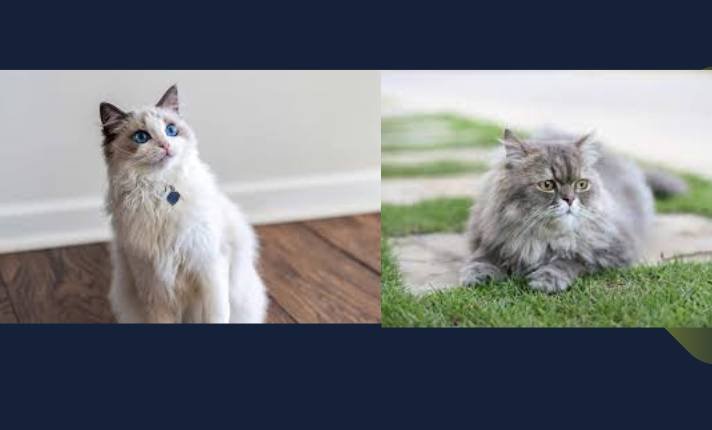Ragdoll and Persian cats are two of the most beloved cat breeds, each with unique traits that make them stand out. While both breeds are known for their affectionate nature and beautiful coats, they differ significantly in appearance, grooming requirements, and personality.
Ragdolls are larger, more sociable, and require moderate grooming, while Persians are known for their flat faces, luxurious fur, and need for daily grooming.
In this article, we’ll explore the key differences between Ragdoll and Persian cats, helping you decide which breed best suits your lifestyle and preferences.
History Of Ragdoll vs Persian Cat
The Ragdoll cat breed was developed in the early 1960s by Ann Baker, a breeder in Riverside, California. Baker used a white domestic longhaired cat named Josephine, who had a notably docile and friendly personality, as the foundation for the breed.
Ragdolls were selectively bred to enhance these traits, resulting in a cat breed that is affectionate, easygoing, and friendly. The name “Ragdoll” was inspired by the breed’s tendency to go limp and relaxed when held, much like a ragdoll toy.
Persian cats are one of the oldest and most recognized cat breeds in the world. Their origins trace back to ancient Persia (modern-day Iran), where they were prized for their luxurious appearance and gentle nature. Persian cats were first introduced to Europe in the 1600s by traders, and they quickly gained popularity among the European aristocracy.
Over the centuries, Persian cats have been selectively bred to enhance their unique features, such as their long, flowing coats, flat faces, and large, expressive eyes.
Physical Differences
Face and Body: One of the most striking differences between Ragdoll and Persian cats is their facial structure. Persian cats have a flat, brachycephalic face, which is a result of selective breeding for a distinctive look. This facial structure, while unique, can lead to health issues such as respiratory problems, tear staining, and dental issues due to the shape of their jaws.
Ragdolls, on the other hand, have a more traditional cat face with a soft, rounded shape and bright blue eyes that convey a friendly and approachable expression. Their facial features are free from the health complications often associated with brachycephalic breeds, making them a healthier option in this regard.
Coat Type and Maintenance: Persian cats have long, dense fur that requires daily grooming to prevent tangles and mats. Their coat is prone to matting, especially around the neck, under the legs, and in other areas where friction occurs. Persian cats also require regular baths to keep their fur clean and free of excess oils, which can lead to skin issues if not properly managed.
In contrast, Ragdolls have a semi-long coat that is softer and less prone to matting. Their fur is silky and does not have an undercoat, which makes it easier to maintain and reduces the amount of shedding. Brushing two to three times a week is usually sufficient to keep a Ragdoll’s coat in good condition, making them a lower-maintenance option compared to Persians.
Size: Ragdolls are generally larger than Persian cats, with a more muscular build and a long, sturdy body. Male Ragdolls can weigh up to 20 pounds, while females typically weigh between 10-15 pounds.
Persian cats, on the other hand, have a more compact, stocky build, with males and females weighing between 7-12 pounds.
The difference in size can be an important factor for potential owners, especially those with space limitations or a preference for a particular cat size. Ragdolls, with their larger size and longer bodies, may require more space to move comfortably, while Persians are well-suited for smaller living environments.

Personality Traits
Ragdolls are often described as “puppy-like” due to their affectionate and loyal nature. They are highly sociable cats who enjoy following their owners around and being involved in household activities. Ragdolls are known for their gentle and laid-back demeanor. They are tolerant of being picked up and handled. Unlike many cats, Ragdolls are not typically aloof; instead, they thrive on companionship and are happiest when they are close to their favorite humans.
Although Ragdolls are generally calm, they do enjoy interactive play and can be quite playful, especially with their favorite toys. They are not overly high-energy but are more active than Persian cats.
Persians are known for their calm, gentle, and affectionate nature. They are sweet-tempered cats that enjoy being around their owners but are not typically demanding attention. Persians prefer a peaceful environment where they can relax without too much disturbance.
They are not as sociable as Ragdolls but are still very loving and enjoy being petted and pampered. Persians are content to sit quietly beside their owners or rest in a comfortable spot, and they are happiest when they can relax in a serene and stable environment.
Persian cats are not very active compared to other breeds. They are content to spend most of their time resting or observing their surroundings. While they do enjoy the occasional play session, especially with interactive toys or feather wands, they are not known for their athleticism or high energy levels.

Grooming & Maintenance Needs
Persian Cats: Grooming is a significant commitment for Persian cat owners. Their long, dense fur requires daily brushing to prevent tangles and mats, which can be painful and lead to skin issues if not properly managed. In addition to brushing, Persian cats often need regular baths to keep their fur clean and free of excess oils.
Their brachycephalic facial structure also means that they are prone to tear staining, requiring regular eye cleaning to maintain their appearance. Persians are also more prone to dental issues due to their jaw structure, so dental care is an important part of their grooming routine. Owners should be prepared to invest time and effort into maintaining their Persian cat’s coat and overall health.
Ragdoll Cats: Ragdolls have a semi-long coat that is much easier to manage compared to Persians. Their fur is less prone to matting, and brushing two to three times a week is usually sufficient to keep it looking healthy. While they do shed, their grooming needs are more manageable, making them a good choice for owners who want a long-haired cat without the intensive grooming requirements of a Persian.
Ragdolls are generally good at keeping themselves clean, and they do not require frequent baths unless they get into something particularly dirty. Regular grooming helps reduce shedding and keeps their coat in good condition, but overall, Ragdolls are considered a low-maintenance breed in terms of grooming.
Health Considerations
Health Considerations: Persian cats are prone to several health issues, primarily due to their brachycephalic features. These include respiratory problems, dental issues, and eye conditions such as excessive tearing and corneal ulcers. They may also suffer from polycystic kidney disease (PKD), a genetic disorder common in the breed that can lead to kidney failure.
Ragdolls are generally healthier but can be prone to genetic heart conditions, such as hypertrophic cardiomyopathy (HCM). Ragdoll owners need to have their cats screened for HCM to catch any issues early.
Both breeds benefit from regular veterinary care, a balanced diet, and a healthy lifestyle to maintain their well-being.

Living Environment Preferences
Persians: Persian cats thrive in quiet, indoor environments where they can relax without much disturbance. They are not fans of loud noises or sudden changes and prefer a stable, predictable setting. They are also strictly indoor cats, as their long fur and flat faces make them ill-suited for outdoor life.
Outdoor environments can pose risks such as respiratory issues, overheating, and exposure to parasites, which can be particularly problematic for Persians due to their unique physical characteristics.
Ragdolls: Ragdolls are more adaptable and enjoy social interaction, making them a good fit for active households. Ragdolls are also best kept indoors due to their trusting nature, which can make them vulnerable if allowed to roam outside. Unlike more independent breeds, Ragdolls are less streetwise and may not recognize potential dangers, making them better suited for an indoor lifestyle.
They are happiest when they are part of the family and are included in daily activities, whether it’s playtime, cuddle time, or simply lounging nearby.

Pros and Cons of Ragdoll vs Persian Cats
| Breed | Pros | Cons |
|---|---|---|
| Ragdoll | Highly affectionate, great with families, easygoing | Moderate grooming needs, large size |
| Persian | Quiet and calm, beautiful appearance | High grooming requirements, health issues |
Choosing the Right Cat for You
When deciding between a Ragdoll and a Persian, it’s important to consider your lifestyle and preferences. If you want a highly social, affectionate cat that loves being around people, a Ragdoll might be the perfect choice. Their playful and gentle nature makes them ideal for families, including those with children or other pets. Ragdolls are also easier to groom compared to Persians, which makes them a good option for owners who want a long-haired cat without the intensive grooming commitment.
On the other hand, if you prefer a more independent, regal cat that requires a quieter environment, a Persian could be a better fit. Persian cats are perfect for individuals who have the time to dedicate to their grooming needs and who appreciate a calm, predictable routine. They thrive in peaceful settings and are well-suited for owners who want a beautiful, low-energy pet that doesn’t require constant interaction. Additionally, consider the grooming requirements: Persians need daily attention to maintain their luxurious coats, while Ragdolls have more manageable grooming needs.

Hey guys, My name is Simon Smith. I’m from Canada and live near Victoria
I live with my sweet family and have 20+ Ragdolls of different types. I love them as my children. My profession is as a hotel manager.
I love to keep Ragdolls and grow their breeder case. I have 7 years of experience.
I’m an expert in cat care. So, I’m here to provide you with new information about my cats daily. This is my blog website, so I request that you kindly visit our site daily.
If you’re a Ragdolls lover and you have any questions or confusion about cats, text me on the Contact Us page or Gmail.
Thank u
